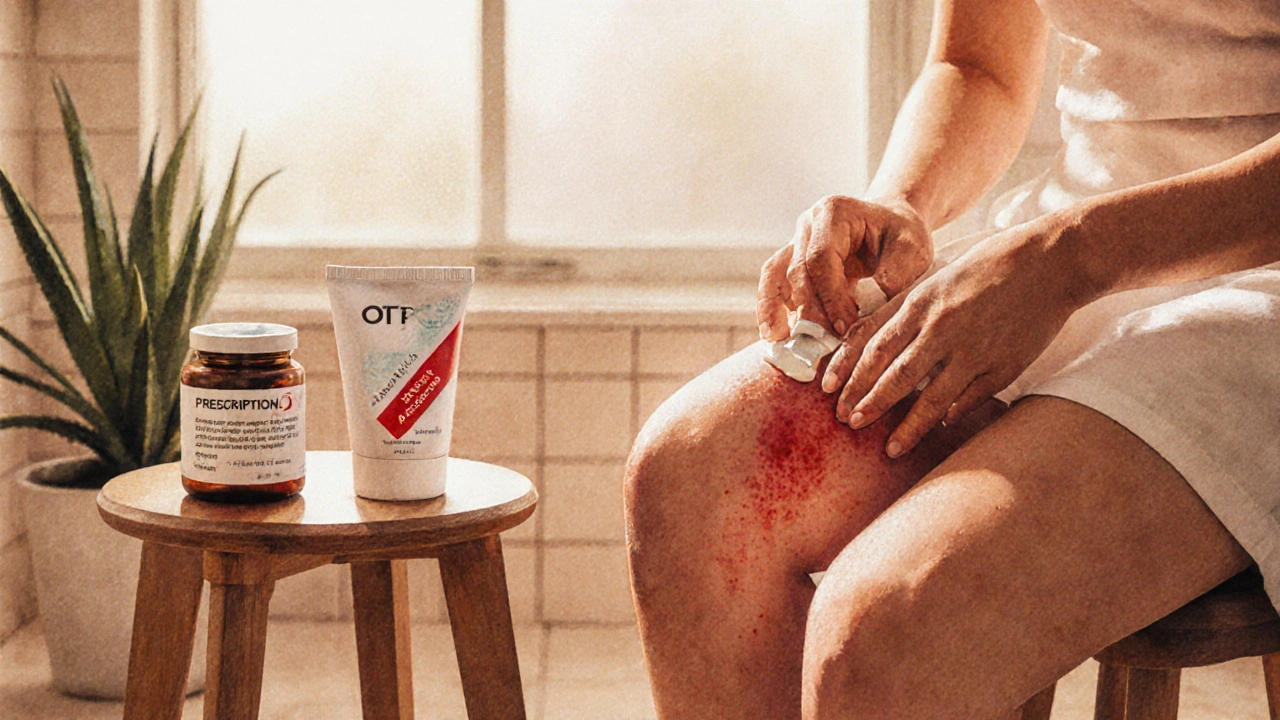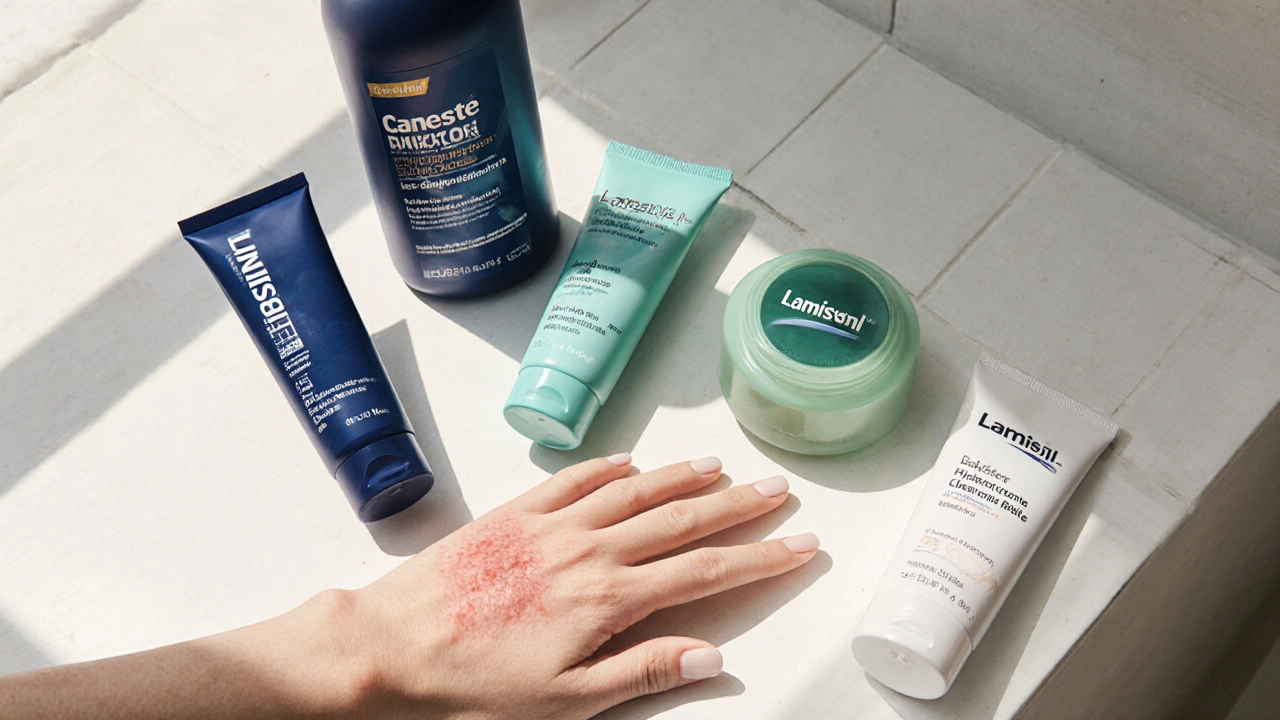Antifungal Cream Selector
Recommended Treatment
Comparison Table
| Product | Ingredients | Indication | Price (AU$) | Side Effects |
|---|
If you’re battling a rash that’s both itchy and fungal, you’ve probably heard of Lotrisone. That combo of a steroid and an antifungal can feel like a shortcut, but is it always the best choice? This guide compares Lotrisone with the most common alternatives, so you can pick a treatment that matches your skin, budget, and lifestyle.
Key Takeaways
- Lotrisone pairs betamethasone (a potent steroid) with clotrimazole (a broad‑spectrum antifungal).
- It’s excellent for inflamed fungal infections but may be overkill for mild cases.
- OTC alternatives like hydrocortisone‑clotrimazole combos or single‑agent antifungals often work just as well with fewer side‑effects.
- Cost, prescription status, and skin‑type sensitivity should guide your choice.
- Proper application-thin layer, once or twice daily, for the full course-is crucial regardless of product.
What Is Lotrisone?
When treating itchy fungal infections, Lotrisone is a topical cream that blends a corticosteroid with an antifungal to calm inflammation while eliminating the fungus.
The steroid component is Betamethasone, a medium‑to‑high potency glucocorticoid that reduces redness, swelling, and itching by suppressing the immune response in the skin.
The antifungal side is Clotrimazole, an imidazole that disrupts fungal cell membranes, stopping growth of dermatophytes, yeasts, and molds.
When Lotrisone Shines
- Inflamed fungal infections - e.g., tinea corporis or candidal intertrigo with noticeable redness and swelling.
- Patients who have tried a plain antifungal without relief because inflammation masks improvement.
- Short‑term use (usually 2‑4 weeks) under doctor supervision to avoid steroid‑related thinning.
Because betamethasone is stronger than over‑the‑counter (OTC) steroids, misuse can lead to skin atrophy, stretch marks, or systemic absorption, especially on large areas or broken skin.

Common Alternatives
Below are the most widely used alternatives, each with its own pros and cons.
- Canesten (clotrimazole 1% cream) - pure antifungal, OTC, inexpensive.
- Lamisil (terbinafine 1% cream) - works fast on dermatophytes, prescription‑only in Australia.
- Nystatin - antifungal for Candida infections, often in cream or powder form, prescription required.
- Hydrocortisone‑Clotrimazole combo - milder steroid (1% hydrocortisone) paired with clotrimazole, OTC in many pharmacies.
- Miconazole (e.g., Daktarin) - another imidazole, broad spectrum, OTC.
Side‑by‑Side Comparison
| Product | Active Ingredient(s) | Typical Indication | OTC/Prescription | Price (AU$) - 30g | Common Side Effects |
|---|---|---|---|---|---|
| Lotrisone | Betamethasone 0.1% + Clotrimazole 1% | Inflamed dermatophyte or Candida rash | Prescription | ~$30‑$45 | Skin thinning, steroid‑flare, irritation |
| Canesten (Clotrimazole) | Clotrimazole 1% | Non‑inflamed tinea, candida | OTC | ~$8‑$12 | Mild burning, itching |
| Lamisil (Terbinafine) | Terbinafine 1% | Dermatophyte infections (athlete’s foot, ringworm) | Prescription | ~$25‑$35 | Rash, rare liver concerns if oral |
| Hydrocortisone‑Clotrimazole | Hydrocortisone 1% + Clotrimazole 1% | Mildly inflamed fungal rash | OTC | ~$12‑$18 | Less skin thinning, possible steroid‑flare |
| Miconazole | Miconazole nitrate 2% | Yeast infections, tinea | OTC | ~$10‑$15 | Burning, itching |
| Nystatin | Nystatin 100,000IU/g | Candida intertrigo, diaper rash | Prescription | ~$20‑$30 | Local irritation, rare allergy |
How to Choose the Right Product
- Assess the severity. If the rash is heavily inflamed, a steroid‑antifungal combo like Lotrisone or hydrocortisone‑clotrimazole may speed relief.
- Identify the fungus. Dermatophytes respond well to terbinafine (Lamisil), while Candida often needs a more potent antifungal like nystatin.
- Consider prescription barriers. OTC options save a doctor’s visit but may lack the steroid potency you need.
- Watch the treatment area. Large body‑surface or thin skin (face, groin) should avoid high‑potency steroids.
- Factor in cost. Lotrisone is pricier; a simple clotrimazole cream can be just a fraction of the price.
By walking through these checkpoints, you can narrow the list to the most appropriate cream without over‑treating.

Practical Tips for Using Topical Creams
- Clean and gently pat the area dry before application.
- Apply a thin layer; more isn’t better and can increase side‑effects.
- Follow the prescribed duration - usually 2‑4weeks for steroid‑containing products.
- Avoid occlusive dressings unless your doctor directs you.
- Monitor for worsening redness, spreading rash, or new pain - stop and seek advice.
Frequently Asked Questions
Can I use Lotrisone for a simple athlete’s foot?
For uncomplicated athlete’s foot, a plain antifungal like clotrimazole or terbinafine is usually enough. Adding a steroid may increase the risk of skin thinning without added benefit.
Is Hydrocortisone‑Clotrimazole as effective as Lotrisone?
It’s less potent on the steroid side (hydrocortisone 1% vs betamethasone 0.1%). For mild‑to‑moderate inflammation it works well and carries a lower risk of thinning. For severe inflammation, the stronger betamethasone in Lotrisone may be preferred.
Do I need a prescription for Lotrisone in Australia?
Yes. Australian regulations classify Lotrisone as a Schedule4 (prescription‑only) medication because it contains a moderate‑potency steroid.
Can I switch from Lotrisone to an OTC cream mid‑treatment?
You can, but only after the inflammation has settled. Talk to your doctor; they may advise tapering the steroid while continuing the antifungal alone.
What are the signs of steroid overuse?
Skin may become thin, develop stretch marks, show increased redness after stopping the cream, or develop a steroid‑flare (worsening rash). If you notice these, stop the product and see a clinician.
Next Steps
If your rash is inflamed and you’ve tried a plain antifungal without success, book a brief appointment with your GP. They can confirm the diagnosis, prescribe Lotrisone if needed, or suggest a milder OTC combo. For mild, non‑inflamed infections, start with an OTC clotrimazole or miconazole cream and see if it clears within two weeks.
Remember, the right choice balances effectiveness, safety, and cost. Use the checklist above, and you’ll avoid unnecessary steroids while still kicking that fungal infection to the curb.


Gene Nilsson
October 5, 2025 AT 15:33It is a matter of ethical responsibility to consider the potential hazards of employing a potent steroid such as betamethasone in a combination cream. The indiscriminate use of Lotrisone, especially without proper medical supervision, may lead to severe dermal atrohy. One must weigh the moral implication of exposing patients to such risks when simpler, over‑the‑counter alternatives exist. In the grand scheme of public health, pruadence should supersede convenience.
Vintage Ireland
October 18, 2025 AT 04:24Hey folks, reading through this guide felt like a warm chat over a cuppa. If your skin’s crying out with redness, it’s easy to want the fastest fix, but remember every rash has its own story. Sometimes a gentle OTC cream can calm the fire without the extra punch of a steroid. Think of it as listening to what your skin is trying to tell you before you shout back with a heavyweight. And if you ever feel stuck, a quick call to your pharmacist can be a lifesaver.
Anshul Gupta
October 30, 2025 AT 16:14Wow, another glorified sales brochure for a prescription cream that most people will never need. The author pretends to be impartial while clearly pushing a pricey combo.
Maryanne robinson
November 12, 2025 AT 05:04Alright, let’s dive deep into why you might reach for Lotrisone and when you should think twice. First off, the steroid component, betamethasone, is a medium‑to‑high potency glucocorticoid that can dramatically reduce inflammation, which is fantastic if you’re dealing with a fiery, swollen rash. However, that same potency carries a baggage of potential side effects, including skin thinning, stretch marks, and even systemic absorption if used over large areas. For many users, especially those with thin skin on the groin or face, those risks outweigh the short‑term comfort. On the antifungal side, clotrimazole is a tried‑and‑true agent that covers a broad spectrum of dermatophytes and yeasts, so it does its job well. When you combine the two, you’re essentially getting a one‑two punch: inflammation goes down while the fungus is killed. That can be a game‑changer for stubborn intertrigo or candida infections that have turned red and painful. But here’s the kicker: most mild to moderate fungal infections don’t need the steroid at all. A plain clotrimazole or miconazole cream applied twice daily for two weeks will often clear the infection without any of the steroid‑related baggage. Budget‑wise, Lotrisone also tends to sit at the higher end of the price spectrum, running $30‑$45 for a small tube, whereas OTC options can be a fraction of that cost. From a prescribing standpoint, doctors usually reserve Lotrisone for cases where the inflammation is severe enough to hinder the antifungal’s efficacy. They’ll also advise a limited treatment window-typically two to four weeks-to minimize the chance of skin atrophy. If you find yourself already on Lotrisone and the rash improves, consider tapering off the steroid component while continuing the antifungal alone. Switching to a milder hydrocortisone‑clotrimazole combo or even an OTC antifungal can maintain the cure while giving your skin a breather. In short, match the strength of the treatment to the severity of the problem; don’t automatically reach for the strongest option. Your skin will thank you for the thoughtful approach, and your wallet will probably thank you too.
Erika Ponce
November 24, 2025 AT 17:55Lotrisone can be super helpful when your rash is really red and puffy, but for a simple athlete's foot a regular clotrimazole cream works fine. The price difference is big, so if you dont need the steroid, save some cash. Also watch out for skin thinning if you use it too long.
Danny de Zayas
December 7, 2025 AT 06:45Just keep the area clean and dry before applying any cream.
John Vallee
December 19, 2025 AT 19:35Fear not, brave skin warriors! The battle against fungal invaders can feel endless, but armed with the right cream, victory is within reach. Lotrisone stands as a mighty ally when inflammation roars, yet remember the lesser‑known heroes like hydrocortisone‑clotrimazole that whisper gentle relief. Each drop of medication is a step toward reclaiming comfort, so apply that thin layer with confidence. Watch the redness recede as the steroid calms the flames while the antifungal hunts the hidden spores. If the rash eases, consider tapering off the steroid to protect your skin’s integrity. And should your pocket protest, the affordable OTC options can still deliver a triumphant finish. Keep your spirits high, and let your skin heal.